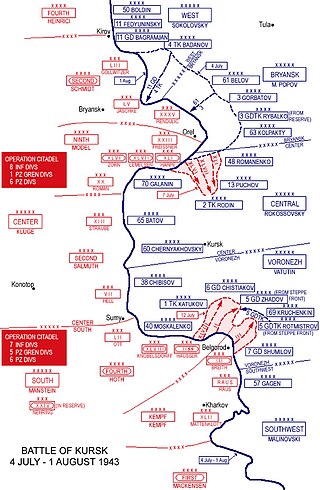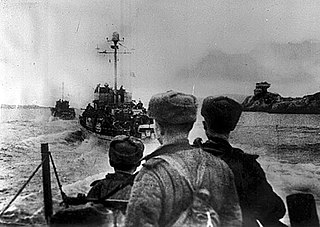
Blitzkrieg or bewegungskrieg is a word used to describe a combined arms surprise attack using a rapid, overwhelming force concentration that may consist of armored and motorized or mechanized infantry formations; together with artillery, air assault, and close air support; with intent to break through the opponent's lines of defense, dislocate the defenders, unbalance the enemies by making it difficult to respond to the continuously changing front, and defeat them in a decisive Vernichtungsschlacht: a battle of annihilation.

The Workers' and Peasants' Red Army, often shortened to the Red Army, was the army and air force of the Russian Soviet Republic and, from 1922, the Soviet Union. The army was established in January 1918 by Leon Trotsky to oppose the military forces of the new nation's adversaries during the Russian Civil War, especially the various groups collectively known as the White Army. In February 1946, the Red Army was renamed the "Soviet Army" - which in turn became the Russian Army on 7 May 1992, following the dissolution of the Soviet Union.

The Battle of Kursk was a major World War II Eastern Front battle between the forces of Germany and the Soviet Union near Kursk in southwestern Russia during the summer of 1943; the Battle of Kursk was the single largest battle in the history of warfare, including being the largest tank battle in history and resulted in a Soviet victory. It, along with the Battle of Stalingrad several months earlier, are the two most oft-cited turning points in the European theatre of the war. It was one of the costliest and fiercest battles of the entire Second World War, with it being the single deadliest armoured battle in history and the opening day of the battle, 5 July, being the single costliest day in the history of aerial warfare. The battle was also marked by fierce house-to-house fighting and hand-to-hand combat.
Military science is the study of military processes, institutions, and behavior, along with the study of warfare, and the theory and application of organized coercive force. It is mainly focused on theory, method, and practice of producing military capability in a manner consistent with national defense policy. Military science serves to identify the strategic, political, economic, psychological, social, operational, technological, and tactical elements necessary to sustain relative advantage of military force; and to increase the likelihood and favorable outcomes of victory in peace or during a war. Military scientists include theorists, researchers, experimental scientists, applied scientists, designers, engineers, test technicians, and other military personnel.

A military, also known collectively as an armed forces, are a heavily armed, highly organized force primarily intended for warfare. Militaries are typically authorized and maintained by a sovereign state, with their members identifiable by a distinct military uniform. They may consist of one or more military branches such as an army, navy, air force, space force, marines, or coast guard. The main task of a military is usually defined as defence of their state and its interests against external armed threats.
Military doctrine is the expression of how military forces contribute to campaigns, major operations, battles, and engagements. A military doctrine outlines what military means should be used, how forces should be structured, where forces should be deployed, and the modes of cooperation between types of forces. "Joint doctrine" refers to the doctrines shared and aligned by multinational forces or joint service operations.
In modern use, the order of battle of an armed force participating in a military operation or campaign shows the hierarchical organization, command structure, strength, disposition of personnel, and equipment of units and formations of the armed force. Various abbreviations are in use, including OOB, O/B, or OB, while ORBAT remains the most common in the United Kingdom. An order of battle is distinct from a table of organisation, which is the intended composition of a given unit or formation according to the military doctrine of its armed force. Historically, an order of battle was the order in which troops were positioned relative to the position of the army commander or the chronological order in which ships were deployed in naval situations.
A table of organization and equipment is the specified organization, staffing, and equipment of units. Also used in acronyms as 'T/O' and 'T/E'. It also provides information on the mission and capabilities of a unit as well as the unit's current status.

Maneuver warfare, or manoeuvre warfare, is a military strategy which emphasizes movement, initiative and surprise to achieve a position of advantage. Maneuver seeks to inflict losses indirectly by envelopment, encirclement and disruption, while minimizing the need to engage in frontal combat. In contrast to attrition warfare where strength tends to be applied against strength, maneuver warfare attempts to apply strength against weakness in order to accomplish the mission.

In the field of military theory, the operational level of war represents the level of command that connects the details of tactics with the goals of strategy.
Principles of war are rules and guidelines that represent truths in the practice of war and military operations.
Deep operation, also known as Soviet Deep Battle, was a military theory developed by the Soviet Union for its armed forces during the 1920s and 1930s. It was a tenet that emphasized destroying, suppressing or disorganizing enemy forces not only at the line of contact but also throughout the depth of the battlefield.
David M. Glantz is an American military historian known for his books on the Red Army during World War II and as the chief editor of The Journal of Slavic Military Studies.

The Petsamo–Kirkenes offensive was a major military offensive during World War II, mounted by the Red Army against the Wehrmacht in 1944 in the Petsamo region, ceded to the Soviet Union by Finland in accordance with the Moscow Armistice, and Norway. The offensive defeated the Wehrmacht's forces in the Arctic, driving them back into Norway, and was called the "Tenth Shock" by Stalin. It later expelled German forces from the northern part of Norway and seized the nickel mines of Petsamo.
Russian military deception, sometimes known as maskirovka, is a military doctrine developed from the start of the 20th century. The doctrine covers a broad range of measures for military deception, from camouflage to denial and deception.
Development of Red Army tactics began during the Russian Civil War, and are still a subject of study within Russian military academies today. They were an important source of development in military theory, and in particular of armoured warfare before, during and after the Second World War, in the process influencing the outcome of World War II and the Korean War.
An offensive is a military operation that seeks through an aggressive projection of armed forces to occupy or recapture territory, gain an objective or achieve some larger strategic, operational, or tactical goal. Another term for an offensive often used by the media is "invasion", or the more general "attack". An offensive is a conduct of combat operations that seek to achieve only some of the objectives of the strategy being pursued in the theatre as a whole. Commonly an offensive is carried out by one or more divisions, numbering between 10 and 30,000 troops as part of a combined arms manoeuvre.
Jonathan M. House is an American military historian and author. He is a professor emeritus of military history at the United States Army Command and General Staff College. House is a leading authority on Soviet military history, with an emphasis on World War II and the Soviet influence upon modern operational doctrine. Together with David Glantz, he wrote multiple books on the Red Army operations on the Eastern Front, most notably When Titans Clashed: How the Red Army Stopped Hitler.
The Reserve of the Supreme High Command (Russian: Резерв Верховного Главнокомандования; also known as the Stavka Reserve or RVGK or RGK comprises reserve military formations and units; the Stavka Reserve acted as the principal military reserve of the Soviet Red Army during World War II, and the RVGK now operates as part of the Russian Armed Forces under the control of the Supreme Commander-in-Chief of the Russian Armed Forces — the President of the Russian Federation.